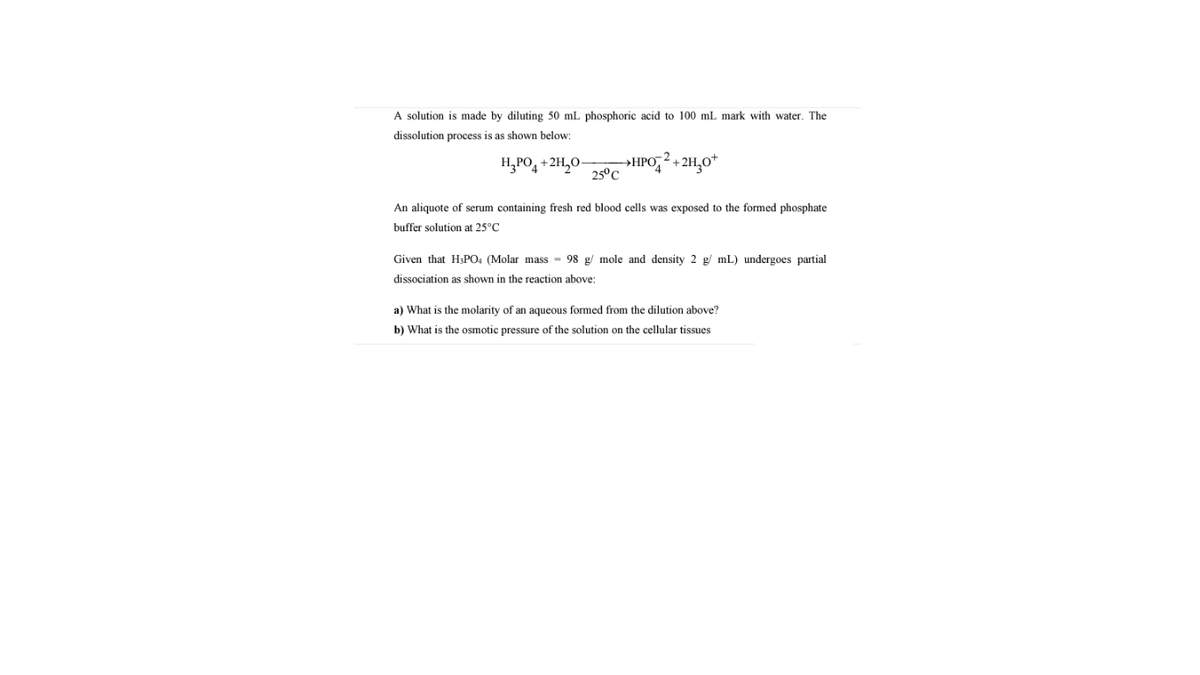A solution is made by diluting 50 mL phosphoric acid to 100 mL mark with water. The dissolution process is as shown below: H,PO4 +2H,0- →HPO,? + 2H,0* 25°C An aliquote of serum containing fresh red blood cells was exposed to the formed phosphate buffer solution at 25°C Given that H&PO. (Molar mass - 98 g/ mole and density 2 g/ mL) undergoes partial dissociation as shown in the reaction above: a) What is the molarity of an aqueous formed from the dilution above? b) What is the osmotic pressure of the solution on the cellular tissues
A solution is made by diluting 50 mL phosphoric acid to 100 mL mark with water. The dissolution process is as shown below: H,PO4 +2H,0- →HPO,? + 2H,0* 25°C An aliquote of serum containing fresh red blood cells was exposed to the formed phosphate buffer solution at 25°C Given that H&PO. (Molar mass - 98 g/ mole and density 2 g/ mL) undergoes partial dissociation as shown in the reaction above: a) What is the molarity of an aqueous formed from the dilution above? b) What is the osmotic pressure of the solution on the cellular tissues
Chapter31: Introduction To Analytical Separations
Section: Chapter Questions
Problem 31.21QAP
Related questions
Question
Problem attached

Transcribed Image Text:A solution is made by diluting 50 mL phosphoric acid to 100 mL mark with water. The
dissolution process is as shown below:
H,PO4 +2H,0-
→HPO,? + 2H,0*
25°C
An aliquote of serum containing fresh red blood cells was exposed to the formed phosphate
buffer solution at 25°C
Given that H&PO. (Molar mass - 98 g/ mole and density 2 g/ mL) undergoes partial
dissociation as shown in the reaction above:
a) What is the molarity of an aqueous formed from the dilution above?
b) What is the osmotic pressure of the solution on the cellular tissues
Expert Solution
This question has been solved!
Explore an expertly crafted, step-by-step solution for a thorough understanding of key concepts.
Step by step
Solved in 8 steps

Knowledge Booster
Learn more about
Need a deep-dive on the concept behind this application? Look no further. Learn more about this topic, chemistry and related others by exploring similar questions and additional content below.Recommended textbooks for you


Principles of Modern Chemistry
Chemistry
ISBN:
9781305079113
Author:
David W. Oxtoby, H. Pat Gillis, Laurie J. Butler
Publisher:
Cengage Learning


Principles of Modern Chemistry
Chemistry
ISBN:
9781305079113
Author:
David W. Oxtoby, H. Pat Gillis, Laurie J. Butler
Publisher:
Cengage Learning